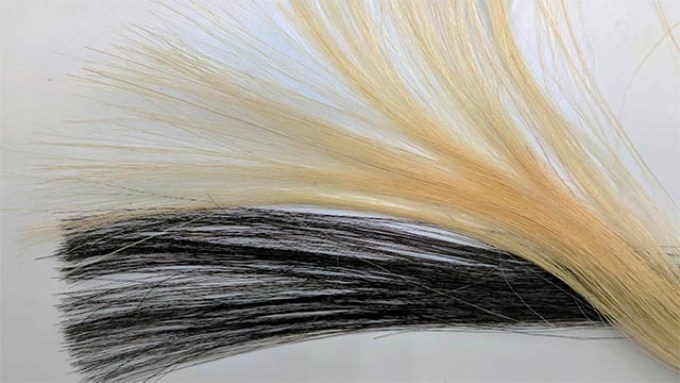Mar 29 2018
Dying hair repeatedly can irreparably harm the silky strands. This issue has been a huge drawback in the beauty industry for over a century.
 (Image credit: Northwestern’s McCormick School of Engineering)
(Image credit: Northwestern’s McCormick School of Engineering)
Researchers from Northwestern University have used materials science to solve this age-old drawback. The team has leveraged wonder material graphene to create a new hair dye that is non-toxic, non-damaging, and lasts through a number of washes without fading. Graphene’s conductive nature also paves way for new opportunities for hair, such as combining it with wearable electronic devices or turning it into in situ electrodes.
The research details were published online on March 15 by the journal Chem. Jiaxing Huang, professor of materials science and engineering in Northwestern’s McCormick School of Engineering, led the research.
Dying hair might appear ordinary and simple, but it’s, in fact, a sophisticated chemical process. Known as the cuticle, the outermost layer of a hair is composed of cells that overlap in a scale-like pattern. Commercial dyes function by using harsh chemicals, such as bleach and ammonia, to first pry open the cuticle scales to allow colorant molecules inside and then activate a reaction inside the hair to yield more color. Not only does this method cause hair to become more brittle, some of the small molecules are also quite lethal.
Huang and his team sidestepped destructive chemicals completely by leveraging the natural geometry of graphene sheets. While existing hair dyes use a concoction of small molecules that function by chemically modifying the hair, graphene sheets are flexible and soft, so they wrap around each hair for a uniform coat. Huang’s formula also includes edible, non-toxic polymer binders to guarantee that the graphene sticks -- and endures through no less than 30 washes, which is the commercial stipulation for permanent hair dye. An extra bonus: graphene is anti-static; therefore it keeps winter-weather flyaways to a minimum.
“It’s similar to the difference between a wet paper towel and a tennis ball,” Huang explained, comparing the graphene’s geometry to that of other black pigment particles, such as iron oxide or carbon black, which can only be used in temporary hair dyes. “The paper towel is going to wrap and stick much better. The ball-like particles are much more easily removed with shampoo.”
This geometry also adds to why graphene is a safer substitute. While small molecules can easily pass through the skin barrier or be inhaled, graphene is too big to enter the body. “Compared to those small molecules used in current hair dyes, graphene flakes are humongous,” said Huang, who is a member of Northwestern’s International Institute of Nanotechnology.
Ever since graphene -- the 2D network of carbon atoms -- entered the science scene in 2004, the prospects for the promising material have seemed virtually endless. With its ultra-strong and lightweight structure, graphene has the potential for numerous applications in high-strength materials, high-performance electronics, and energy devices. But the development of those applications repeatedly requires graphene materials to be as structurally flawless as possible so as to realize extraordinary mechanical, electrical, or thermal properties.
The most significant graphene property for Huang’s hair dye, however, is just its color: black. So Huang’s team used graphene oxide, an imperfect version of graphene that is an inexpensive, more available oxidized derivative.
“Our hair dye solves a real-world problem without relying on very high-quality graphene, which is not easy to make,” Huang said. “I feel optimistic about this application.”
Still, future versions of the dye could soon potentially leverage graphene’s outstanding properties, including its extremely conductive nature.
“People could apply this dye to make hair conductive on the surface,” Huang said. “It could then be integrated with wearable electronics or become a conductive probe. We are only limited by our imagination.”
Thus far, Huang has created graphene-based hair dyes in several shades of black and brown. Subsequently, he plans to try out more colors.
The research paper is titled “Multifunctional graphene hair dye.” the paper’s co-first authors are Chong Luo and Lingye Zhou, members of Huang’s laboratory.